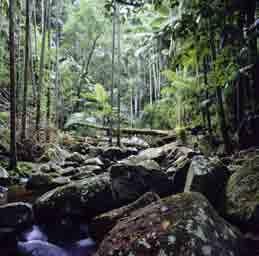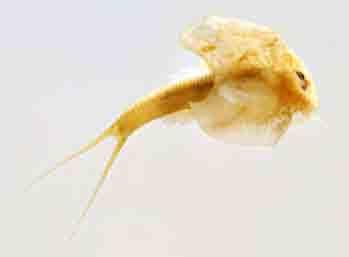
4 minute read
In your backyard with Martyn Robinson
THE MORE MOVING PARTS THE BETTER...
One of the interesting differences between human-designed systems and natural ones is the inverse effect of increasing complexity. With human systems, tools and machines, the more complex they are, the more likely they are to break down. One tiny factor or faulty component can cause an entire system to grind to a halt, and fixing the problem usually calls for replacement of parts rather than repair. Similarly the more refinement, or work, needed to produce the device, the more quickly it will fail or need maintenance. Each component of a system depends on the others, rather than functioning in isolation – and there is often very little ‘give’ in the more complex systems. A hammer is less likely to fail than a hand drill, which is less likely to fail than an electric drill, and so on. In a complex machine like a computer, one tiny fault can (and often does) stop work until a specialist can come to adjust an electronic feature, reinstall software or replace some component. Yet the home handyman can hammer away for weeks or months until the head falls off the hammer! In natural systems too, each component depends on others, rather than functioning in isolation. Simple systems are prone to failing as too few components are involved, and there is little ‘give’ or resilience. Consider, say, a temporary puddle consisting of five species – one plant, three herbivores and a carnivore. If the plant should go, the herbivores starve and die out, shortly followed by the carnivore. If we compare the puddle to a more complex system – say, a river or lake – there are many more species, niches and diets involved. If one species of plant disappears, the herbivores can turn to others. Similarly, the predators can prey on the herbivores or on other carnivores, and the diversity and populations ensure they won’t eat out their food supply completely. The system is far more stable if it has developed all together in a natural system over a long time. So why then are so many natural systems in trouble right around the world? The answer is, predictably, us in most cases. We now have inputs into most, which tends to make them ‘smaller’
Left
Rainforests are among the most diverse habitats on Earth. Photo by Stuart Humphreys.
(think of land clearing and swamp draining) or less complex by reducing key species and populations (overfishing, clear-felling trees etc). With fewer species, systems become less stable. When we add other decidedly unnatural inputs, like pollution, pest species and climate change, it is not surprising that many natural areas are struggling to survive. Left to their own devices, some natural systems have run, and may continue to run, more or less unchanged for thousands of years. Will any human- made systems last as long?
JUST ADD WATER
MARTYN ROBINSON
IS THE MUSEUM’S RESIDENT NATURALIST
As a child, I was fond of the ‘Bugs Bunny’ cartoon shows. Although I always felt sorry for him, my favourite character was Wile E Coyote. I particularly liked his various Acme instant products – just add water and a tiny dehydrated ‘pill’ would transform into a grand piano or something equally improbable. I was always a little disappointed that real life wasn’t quite the same – until I discovered that, for some species, it is like that. Almost. Australia is renowned as one of the driest continents, with droughts lasting decades affecting the arid interior. So it might come as a surprise to learn that these dry areas are home to a wealth of unusual animals, particularly some invertebrates, that live and grow only after rain or flooding. The secret of success for most of these animals is the egg stage, which can withstand years of drought, extreme heat and cold, and abrasion from wind and sand and yet still hatch when rain or floodwaters eventually come. The water, of course, causes the eggs to rehydrate and hatch, but then the race is on and the animals must grow, mature into adults and breed before the temporary water body, whether a puddle or a lake, dries up again. So rapid is their growth that, within days of heavy rains, roadside ditches will be teaming with life, leading many observers to conclude (incorrectly) that the animals must have come down in the rainstorm itself (though we know the eggs are distributed by wind, birds or floodwater). Perhaps the most famous of these ‘temporary puddle’ animals – most of which are crustaceans – are the two species of tadpole shrimp, Triops australiensis and Lepidurus apus. These strange and quite large crustaceans resemble the horseshoe crabs of America and Asia, except that ‘tadpole shrimp’ eyes are concentrated in a cluster at the front rather than at the sides. I used to think they were called ‘tadpole shrimp’ because of their appearance but having seen them shred and eat some real tadpoles inhabiting the same temporary puddles out west I am not so sure! There are other, gentler, crustaceans which have this abbreviated life cycle, such as the various brine shrimps (sold as ‘sea monkeys’, although they never live in the sea!) which hatch in salt lakes such as Lake Eyre. In freshwater puddles you can find feather shrimp and clam shrimp, and their names give a good guide to their appearance. There’s another whole world of amoeba and other microscopic life forms that are similarly adapted. So there you go – (almost) instant life – just add water! Wile E Coyote would have been proud!

Above
The shield shrimp, Triops australiensis, can appear in large numbers after flooding in desert wetlands. Photo by Stuart Humphreys.










